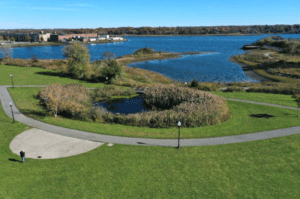Who is a member?
Our members are the local governments of Massachusetts and their elected and appointed leadership.

The city of New Bedford is looking to remove the reed-ringed pond in Riverside Park and build a salt marsh. (Photo courtesy city of New Bedford)
With visions of a salt marsh along the Acushnet River, New Bedford hopes that an underused stretch of parkland will soon offer enhanced recreation, new wildlife habitat, improved environmental justice for local residents, and another means of addressing climate change.
Working with a nonprofit, Groundwork Southcoast, the city has hired a firm to conduct a feasibility study and develop design and construction plans to remove a reed-ringed pond and build a salt marsh in Riverside Park. The city received more than $93,000 through the Buzzards Bay National Estuary Program to cover the project’s initial phase.
“New Bedford has always been so closely connected to the water,” said Mary Rapoza, New Bedford’s director of parks, recreation and beaches. “Most of the waterfront is built up, and there aren’t a lot of places where we can do this kind of work to recreate the salt marshes that would have normally been there. So this is a really great opportunity to recreate that salt marsh.”
The salt marsh would give the nearby North End neighborhood greater access to the water, and would better protect the neighborhood from flooding, Rapoza said.
“One of the biggest benefits is the stormwater management,” Rapoza said. “It is a tidal river, and that neighborhood does experience flooding with heavy rains and high tides. So the salt marsh will help alleviate some of that because salt marshes are basically big sponges.”
Rapoza said the salt marsh would enhance a park that serves as a gathering spot for a neighborhood of largely Central American and Cape Verdean residents, an area filled with triple-decker homes and small backyards that offer little room for outdoor living. As a result, residents have embraced the 22-acre park, which includes a community garden and features a Central American-themed food court on Sundays, she said.
But while plenty of park amenities attract visitors, the existing pond has had the opposite effect. When the park was built two decades ago, the river was part of a federal Superfund site, and the pond was designed to serve as a buffer between people and the contaminated water. But the pond hasn’t functioned as planned, and the surrounding 10- to 12-foot invasive phragmite reeds impede visibility, create safety concerns and encourage illegal dumping.
About a year ago, the city was approached about removing the phragmites by Groundwork Southcoast, which has undertaken numerous projects in Riverside Park over the past seven years, including managing the community garden, planting native plants, and using goats to remove invasive plants. But Groundwork Southcoast’s proposed phragmite removal prompted experts to decide that the pond itself needed to go, and that a salt marsh would be preferable, especially with the Superfund cleanup expected to wind down by next year. Already, the cleanup has brought back herring, egrets and ospreys, Rapoza said.
Once the current phase of the salt marsh project has been completed, Rapoza said, New Bedford will seek grant funding to support the construction costs, and hopes to complete the salt marsh by the end of 2026. She said the city won’t know the construction cost until the analysis is finished and officials decide exactly how big the salt marsh will be.
New Bedford might also build a boardwalk through the marsh, so that people can enjoy it while it helps protect the city. As climate challenges mount, parks such as Riverside increasingly offer residents safe recreational spaces and a respite from rising temperatures, said Maura Valdez, Groundwork Southcoast’s executive director.
“Our park spaces are not going to become less valuable as time goes on,” Valdez said. “They are going to become more and more valuable.”